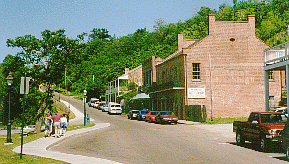

|
________________________________________ Under-the-hill, Natchez
Natchez, Adams County, Mississippi Photographs Copyright Dale Woosley, Natchez - 1997 |
|
Some Steamboat Accidents on the Lower Mississippi
Adams County is maintained by Carolyn Switzer Copyright Carolyn Switzer 2002-2009 - All Rights Reserved
The area known as Natchez Under-The-Hill has endured a checkered past. Once a busy port where everything from luxurious steamboats, to lowly flatboats docked, Under-The-Hill and it's once infamous Silver Street is today a popular tourist attraction. During the late 1700's, and into the 1900's, Under-The-Hill was comprised of a wide flat area that extended several hundred yards from the Mississippi River to beneath a high bluff on which Fort Rosalie once stood, and on which the city of Natchez was later built. The first steamboat to arrive at Under-The-Hill was the New Orleans. Piloted by Nicholas Roosevelt, the fragile little steamer made the trip down the river in 1811, the same year of the earthquake that struck along the New Madrid fault, and altered the course of the mighty Mississippi. The New Orleans was only one of thousands of steamboats, paddle wheelers, barges, flatboats, and so-called quarter boats that Under-The-Hill was to welcome to it's shore. There were mail packets, luxurious passenger boats, coal barges from Cincinnati, gunboats, and steamboats so over-laden with cotton bales, it was hard to imagine they were sea-worthy. Many were not, and terrible accidents occurred regularly up and down the river. Steamboat captains became legendary figures, and it is sometimes difficult to separate fact from fiction.
As trade opened on the Mississippi River, Natchez Under-The-Hill began to grow. Houses, businesses, and warehouses appeared. The Bluff City Railway built parallel tracks leading from the landing up the bluff, to Natchez, for ease in transporting goods. Enterprising individuals, equipped with only a cart and mule, hauled freight from the landing to any part of the city for about 50 cents. By 1885 a mule-drawn trolley ferried passengers up and down Silver Street, to the top of the bluff. A ferry was established that linked Under-The-Hill with the small town of Vidalia, Concordia Parish, LA, across the river. For many years, the McNeely family operated the only ferry that made the crossing.. Other businesses located on the landing were St. Jacobs Oil, Boar Dining and Lodging, C. P. Pollard, D. Moses and Sons "Cheap Cash Store," O'Neil and Company coal yard, and Rumble and Wensel "Groceries and Provisions, Liquor sac," one of the most popular and durable businesses located Under-The-Hill. For many years, Under-The-Hill was the busiest port between Ohio and New Orleans. The reputation of Under-The-Hill was, in part, less than desirable. Arriving with the cotton, mail, coal, and molasses were drunks, bandits, murderers, and other rabble-rousers who, each evening, frequented the brothels, bars, and taverns that dotted Silver Street. Fist and knife fights were considered the norm, and muggings, shootings, and murders were a regular occurrence. One or more murders per evening were not unusual. Other persons who streamed into Under-The-Hill were victims of steamboat accidents. The river offered it's share of natural dangers: snags, floating debris, storms, current, sudden high water. But many accidents were man-made, and could have been avoided. In an attempt to increase profits, steamboat companies piled as much freight on board as possible. Drunken and inept skippers and pilots fell asleep at the helm, or made poor decisions. Many boats were unsafe, and in need of repair. Boiler explosions and fires accounted for much loss of life. Inevitably, port traffic at Under-The-Hill began to subside. When the packet companies began to realize that passenger travel accounted for less revenue than freight, scheduled passenger excursions began to decline. Eventually, the railroad became the primary means of transportation. Travel by rail was much faster than the slow cumbersome paddle-wheelers, and much safer. Also, freight did not have to be transported to and from the Mississippi River. It could travel overland, cutting off up to hundreds of miles on a journey. The final decline of Under-The-Hill occurred after 1930, when the US Army Corps of Engineers cut of an upstream loop causing the river current to move faster and stronger than ever. The endless battering on the soft loess soil created a steady erosion of the landing, and the bluff behind it.
All that remains today, of Under-The-Hill, is the lone Silver Street and one row of restored brick and wood buildings. Little remains as evidence of it's century of importance as a port, or of it's wild and bloody nights. Today, housed in the old buildings, are several restaurants and gift shops, as well as the office for the Lady Luck, a new paddle wheeler gambling boat permanently moored Under-The-Hill. Two to three times a week one of the larger steamboats arrives from St. Louis or New Orleans, and docks overnight to allow it's passengers an opportunity to enjoy a day in Natchez. Even today, however, the mighty Mississippi reins havoc on the soft loess of the bluffs and Under-The-Hill. Melting snow from the Dakota's, in the spring of 1997, made it's way down the river. The river rose to flood stage, and despite rows of sandbags, private vehicle transportation was halted, and for awhile, the Lady Luck was closed.
Butler, Pierce; The Unhurried Years; Memories of the Old Natchez Region; Louisiana State University Press Gandy, Joan W. and Gandy, Thomas H.; The Mississippi Steamboat Era; Dover Publications, New York, 1987 Hunter, Louis C.; Steamboats on the Western Rivers; Dover Publications, Inc, New York; 1949 Keating, Bern; The Mighty Mississippi; National Geographic Society, 1971. Moore, Edith Wyatt; Natchez Under-The-Hill; Southern Historical Publications, Inc.; Natchez, Mississippi, 1958 Pack, Ellen Jane Allen; The Scully & Bauer Families of Natchez, Mississippi; 1996 |
|
and on The Lower Mississippi River |
|
|
|
|
| Arkansas City |
|
Destroyed during the St. Louis Tornado of 1896 |
| Autocrat |
|
Collision - Lower MS - 30 lives lost |
| Banner State |
|
Caught Snag while heading upriver from New Orleans |
| Belle Memphis |
|
Caught Snag - damaged beyond repair |
| Belle Of Clarksville |
|
Collision - Lower MS - 36 lives lost |
| Brandywine |
|
Near Memphis - Fire caused by spark from the chimney - 125-155 lives lost. |
| Buckeye |
|
Collision - Lower MS - 50-80 lives lost |
| Chalmette |
|
Caught Snag |
| City of Vicksburg |
|
Damaged in the Tornado of 1896 at St. Louis |
| Constitution |
|
Explosion on Lower MS near St. Francisville - 11 lives lost |
| David Swain |
|
Hit stump off Natchez Under-The-Hill |
| John Adams |
|
Struck snag 200 miles S of Memphis - 123 lives lost |
| John L. Avery |
|
Overloaded - Struck snag upriver from New Orleans & sank within 5 minutes - 80 to 150 lives lost. |
| Maria |
|
Collision - Lower MS 30-50 lives lost |
| Missouri Belle |
|
Collision - Lower MS - 30 lives lost |
| Monmouth |
|
Collision with the Warren - Lower MS - 235-400 lives lost; One of the steamboats employed in the removal of the Creek tribes. At least 500 Indians were on board at time of collision. |
| Shepherdess |
|
Struck snag late at night 3 miles N of St. Louis. 40 to 100 lives lost. |
| Talisman |
|
Collision - Lower MS - 50-100 lives lost |
| Tennessee |
|
|
| Tennessee Belle |
|
Burned near Natchez Island |
| T. P. Leathers (III) |
|
Developed Leak due to weight of cargo - Went aground a few miles above Natchez - Later raised and repaired. |